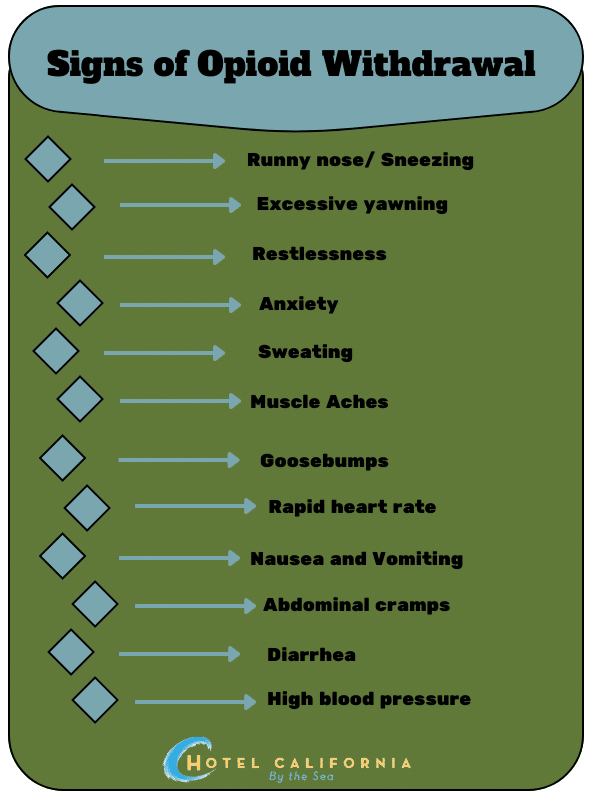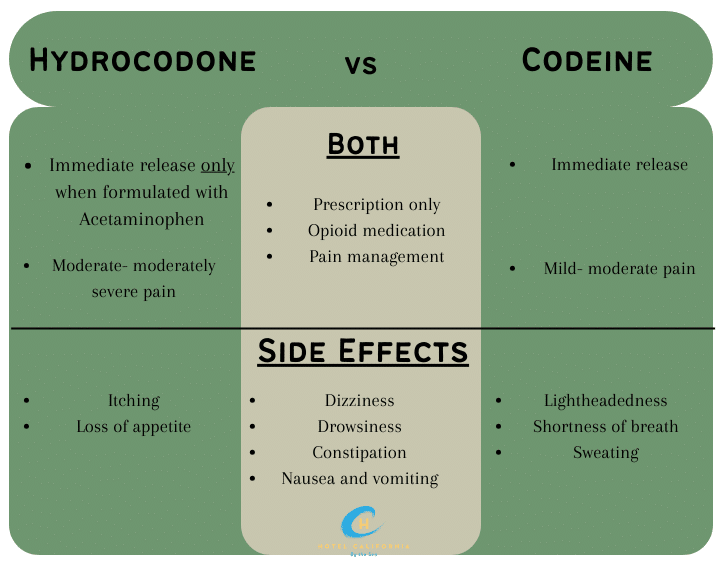What is the difference between Codeine vs Hydrocodone?
Opioid prescription pain medications are highly potent and one of the most addictive substances that have led to decades of overdose deaths in the United States. The overprescribing of these drugs along with easy access and availability has contributed to prescription drug abuse and illegal opioid drug abuse. Two of the most popular medications are codeine and hydrocodone. Though they are both opioid medications, codeine and hydrocodone are prescribed to treat different types of pain.

Codeine is typically prescribed to treat mild to moderate pain and is used when similar types of analgesics such as acetaminophen or ibuprofen are not appropriate. It is often used to treat chronic pain, chronic coughing and symptoms of diarrhea. Hydrocodone is prescribed to treat chronic and more severe pain. It is a more potent formula with a higher risk of developing dependency. It is often used to treat symptoms of chronic pain and severe back pain. Hydrocodone is one of the most abused opioids in the U.S.
Codeine vs Hydrocodone
Both codeine and hydrocodone are prescription opioid pain medications with a high risk of abuse. They are antitussives and narcotic analgesics. Long-term use of either medication can lead to tolerance and dependence in which users may experience withdrawal symptoms once drug use has significantly decreased or stopped. They work by relaxing and calming the body’s nervous system. The opioids release the neurotransmitter dopamine into the brain which provides a rush of calming sensations followed by deep relaxation. This slows down or blocks pain sensors allowing the user to feel a sense of calm, sedation and in high doses, euphoria.

Codeine
- Prescription pain medication
- An opioid is a natural opioid formulated from the seeds of the poppy plant
- Schedule II or Schedule V Controlled Substance
- Codeine works by converting into morphine in the brain
- Widely regarded as the gold standard for cough suppressant drug
- Brand names – Codral (aspirin and codeine), Nurofen (ibuprofen and codeine), Robitussin
- Can provide pain relief from conditions such as mild to moderate pain, dry and irritating cough, cold and flu
- Side effects include – dizziness and lightheadedness, shortness of breath, tiredness, confusion, mild euphoria, restlessness, blurred vision, feelings of heavy limbs and stiffness, sweating, low blood pressure, decreased heart rate, stomach issues and difficulty urinating
- Long-term side effects of abuse include – nausea, constipation, itchy skin, loss of appetite, irregular menstrual cycle, muscle tension and uncontrolled muscle twitching, drug tolerance, drug dependence, doctor shopping, financial issues, social issues and issues with personal relationships
- Slang and street names – Cody and Captain Cody
- Off-label uses include chronic cough suppressant, treating restless leg syndrome and persistent diarrhea
- Half-life – 3.5 hours
- Price – 100 tablets, dosage of 60mg, $154.40
Hydrocodone
- Hydrocodone is a semi-synthetic opioid
- Schedule II Controlled Substance
- Hydrocodone works by breaking down into norhydrocondone and hydromorphone in the brain
- Provides pain relief from severe pain
- Hydrocodone is a stronger opioid than codeine with a higher potential for misuse
- FDA-approved for pain management and to treat severe chronic pain
- Opioid receptor agonist activates the mu-opioid receptors (which are located in the central nervous system around the brain and spinal cord) to produce analgesic effects on the body
- Side effects include – itching, drowsiness, loss of appetite, euphoria and sedation
- Long-term side effects of abuse include – slowed heart rate, difficulty breathing, development or worsening of depression and anxiety, feelings of fear, sleep conditions such as insomnia, muscle aches, seizures and a high risk of overdose
- Slang and street names – Hydros and Vico
- Brand names – Vicodin, Norco, Lortab
- Half-life – 4 hours
- Price – 60 tablets, dosage of 10 mg, $518.73

What is Prescription Pain Medication Abuse?
Most if not all prescription painkillers fall under one category of drugs. Opioids. When a person has become tolerant, dependent and then addicted to pain medication, they have developed an opioid use disorder. Opioid use disorder is a disease characterized by compulsive use of opioid drugs despite wanting to stop using drugs when it negatively affects them physically and emotionally. It is a serious mental health condition.
Opioid medications are prescribed by physicians to treat pain. Opioid use and misuse is the leading factor of drug overdose deaths in the United States for decades and continue to grow. This due to the fact that it is so easily available. It can be obtained through a prescription and many users can find it in their family drug cabinet at home.
An addiction to opioids usually begins innocently through the use of prescription drugs. Despite using the drug as per the recommendation by a clinician, there is still a risk of developing an addiction. Users who begin with prescription opioids usually move on to illicit opioids and continue to use in order to prevent uncomfortable symptoms of withdrawal, simply to get high or as a form of self-medication in dealing with their emotional well-being.
When users start taking opioids for the pleasurable effects of getting high, shortly after, the feel-good sensations feel less and less. This is due to the user developing a higher tolerance for the drug. This then causes the user to seek out more drugs to take them in higher doses or more frequently in order to produce the same feelings.
The most common symptoms of opioid abuse include continuing to use despite negative outcomes, physical dependence and experiencing withdrawal symptoms. Users may also experience cravings, which are overwhelming physical and emotional urges to use opioid drugs. Other side effects can include drowsiness, frequent flu-like symptoms, changes in sleep, weight loss, isolation from friends and family and unhealthy relationships with friends and family.
Check Your Insurance Coverage for FREE
Find out if your insurance covers addiction treatment in minutes. We accept most insurance!
Signs you may have an Opioid Use Disorder
- Regular or daily use of opioids
- Taking more opioids than prescribed or recommended – Taking more dosage or more often
- Feeling flu-like symptoms and other withdrawal symptoms when you stop taking opioids
- Doctor shopping for more medication from different places
- Using more opioids over time
- Significant weight loss
- Frequent constipation
- Extreme mood changes
- Decline in personal hygiene
- Taking opioid medication in non-prescribed methods
- Getting opioids outside of a doctor’s prescription or pharmacy
Reach out to Hotel California by the Sea
We specialize in treating addiction and other co-occurring disorders, such as PTSD. Our Admissions specialists are available to walk you through the best options for treating your addiction.
Treatment for Opioid Use Disorder
Opioid use disorder and overdose is an epidemic in the United States. Many opioid addictions can start with prescription pain medications such as codeine and hydrocodone. At Hotel California by the Sea, our specialized treatment program focuses on treating those with an addiction to opioids. Opioids are highly habit-forming and can cause dangerous physical and psychological effects on the body and well-being of a person.
Within our program, we offer all levels of care including detox, residential and outpatient programs. We treat our patients both pharmacologically as well as through cognitive and behavioral therapies. In some cases, the use of medications has a significant impact on the recovery journey. Medications such as methadone, buprenorphine and naltrexone are commonly used as part of medication management when dealing with an opioid addiction.
Effective and intensive therapies such as CBT, DBT and EMDR therapy also provide clients with a deeper insight into their addiction. Hotel California by the Sea is dedicated to providing a safe and unbiased environment where all can recover and overcome their addiction.
References:
https://adf.org.au/drug-facts/codeine/
https://www.bicyclehealth.com/opioid-education/hydrocodone/vs-codeine
https://www.hopkinsmedicine.org/health/conditions-and-diseases/opioid-use-disorder
https://www.destinationsforteens.com/destinations-blog/codeine-vs-hydrocodone-2/
https://www.psychiatry.org/patients-families/opioid-use-disorder
https://www.ncbi.nlm.nih.gov/books/NBK526029/
https://www.ncbi.nlm.nih.gov/pmc/articles/PMC2921574/
https://www.ncbi.nlm.nih.gov/books/NBK537288/
https://www.healthline.com/health/pain-relief/codeine-vs-hydrocodone#the-right-fit
https://www.destinationsforteens.com/destinations-blog/codeine-vs-hydrocodone-2/
